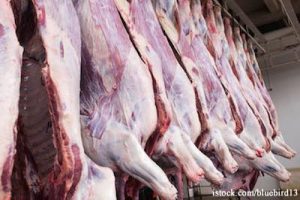A report by the Office of Inspector General (OIG) has found problems with the camera-grading system used to assess about 40% of the beef carcasses harvested and processed in the U.S. These automated systems help use staff time efficiently, but it may not be established in an objective and transparent way.
 The USDA’s Agricultural Marketing Service (AMS) facilitates the competitive and efficient marketing of agricultural products and provides grading services in more than 1,000 establishments. It works in conjunction with the USDA’s Food Safety and Inspection Service (FSIS), which is the public health regulatory agency of the department overseeing food safety and plant inspections.
The USDA’s Agricultural Marketing Service (AMS) facilitates the competitive and efficient marketing of agricultural products and provides grading services in more than 1,000 establishments. It works in conjunction with the USDA’s Food Safety and Inspection Service (FSIS), which is the public health regulatory agency of the department overseeing food safety and plant inspections.
Inaccuracies and loopholes in the system may be costing consumers millions of dollars every year on beef that is actually a lower grade than it is labeled. The report states, “as long as the Agricultural Marketing Service relies on and encourages the use of these cameras to assist AMS graders, the methodology used to define the cameras’ grading classifications must be established in a way that is objective and transparent to all interested stakeholders.”
U.S. standards for beef carcass grades were formulated in 1926 and promulgated under the Agricultural Marketing Act of 1946. The standards are the basis for reporting the quality of beef, according to grade, across the industry. The classifications aren’t required in order to sell beef, but they are used as a marketing tool. Inspections for safety are required.
Grading is applied by standards on fat and fat marbling, color, age, and the rib eye area. In 1978, the Government Accountability Office said that consistency in grading was lacking, so AMS began to develop instruments to make consistency more attainable.
The score for marbling is most important; it’s divided into 100 marbling points from 100 to 11,000. Minimum Prime is 700, minimum Choice is 400, and minimum Select is 300. The Prime grade is applied to 2 to 3.5% of all beef produced in this country. It’s usually not for sale in grocery stores, since restaurants purchase most of it. It is illegal to mislabel beef with an incorrect grade.
Camera grading, called “electronic instrument grade augmentation” was implemented in September 2009, giving slaughter plants the option to use the cameras or use manual grading. When AMS established the classifications of grading, industry said the cameras didn’t conform to manual grading done by actual people, so AMS lowered the grades. That means more beef may be receiving higher grades. If the grades aren’t correct, consumers are overpaying for the beef they are buying to the tune of $375 million a year, according to OIG calculations.
Recommendations include verifying the accurate of the system, having methodologies evaluated by third-party experts, reviewing certification programs, and ensuring that the cameras are calibrated and maintained. Interviews with 16 AMS graders were conducted to understand the effectiveness of grading cameras.





Please explain your note that only 2% of all carcasses should grade prime. All beef producers are attempting to improve beef quality grade through improved genetics, improved animal health and well being. These factors are not capped to a 2% subset of the beef supply. Is it possible that the historical prevalence of prime beef is just that – history? Could it be that the beef industry IS producing higher quality grade beef?
Everything in the story came from the OIG study. For answers to those questions, please write to that agency.
I also found that 2% number at other sources. This page: http://www.quora.com/How-would-a-normal-person-get-Prime-grade-beef-to-cook-with-at-home-and-how-much-would-it-cost#
says that 3% of all graded beef is prime.
Please note that grading is not about quality or genetics – it’s all about marbling and fat content. WIth people wanting to eat less fat, in 1987 the National Cattlemen’s Association started a movement for leaner beef. Prime and Choice cuts have more fat.
In addition, here is the USDA information about prime beef as percentages of total graded: http://www.ams.usda.gov/AMSv1.0/getfile?dDocName=STELPRDC5068968
It varies between 2 and 4% every year.
Also see: http://www.steakperfection.com/grade/
The next to last paragraph of this article contains some ‘bogus’ statements. For one thing, AMS did not lower grades in response to the camera study. Secondly, industry did not state that the cameras did not conform to manual grading by people. I reviewed the study on the evaluation of instrument grading, and it was a little more precise and accurate than human graders.
Everything in the story came from the OIG study.